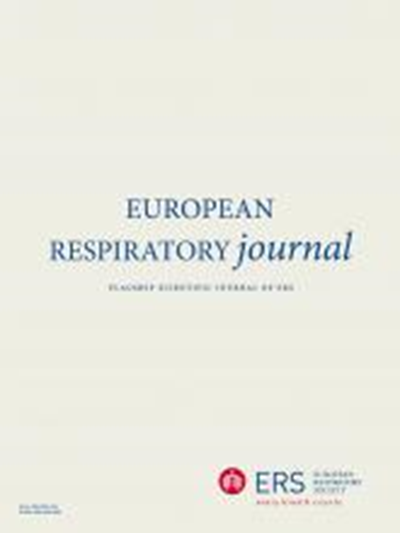牛津胸膜感染内分型研究(TORPIDS-2):胸膜感染患者的胸膜液蛋白质组学显示出多种中性粒细胞反应的特征。
IF 16.6
1区 医学
Q1 RESPIRATORY SYSTEM
引用次数: 0
摘要
背景胸膜感染是一种复杂的疾病,临床疗效不佳,且在全球的发病率不断上升,但其生物内型仍不为人所知。过滤后共保留了 449 个蛋白质。采用无监督分层聚类和 UMAP 分析对样本进行聚类,并进行通路分析以确定生物过程。将路径分析确定的蛋白质特征与 16S rRNA 下一代测序确定的微生物学特征进行比较。结果中性粒细胞脱颗粒与糖酵解增加(OR=281,p<2.2E-16)和磷酸戊糖激活(OR=371.45,p<2.2E-16)相关。以肺炎链球菌为主的样本表现出较高的中性粒细胞脱颗粒(OR=12.08,p=0.005)、糖酵解(OR=11.4,p=0.006)和磷酸戊糖活性(OR=12.82,p=0.004)。另一方面,以厌氧菌和革兰氏阴性菌为主的样本表现出较低的中性粒细胞脱颗粒(OR=0.15,p=0.01)、糖酵解(OR=0.14,p=0.01)和磷酸戊糖活性(OR=0.07,p=0.001)。肝脏和视黄醇 X 受体(LXR-RXR)通路活性的增加与较低的一年期死亡风险相关(OR=0.24,p=0.04)。使用激动剂靶向治疗 LXR-RXR 通路是一种可行的治疗方法。本文章由计算机程序翻译,如有差异,请以英文原文为准。
Pleural fluid proteomics from patients with pleural infection shows signatures of diverse neutrophilic responses: The Oxford Pleural Infection Endotyping Study (TORPIDS-2).
BACKGROUND
Pleural infection is a complex disease with poor clinical outcomes and increasing incidence worldwide, yet its biological endotypes remain unknown.
METHODS
We analysed 80 pleural fluid samples from the PILOT study, a prospective study on pleural infection, using unlabelled mass spectrometry. A total of 449 proteins were retained after filtering. Unsupervised hierarchical clustering and UMAP analyses were used to cluster samples and pathway analysis was performed to identify the biological processes. Protein signatures as identified by the pathway analysis were compared to microbiology as defined by 16S rRNA next generation sequencing. Spearman and exact Fischer's methods were used for correlation assessment.
RESULTS
Higher neutrophil degranulation was correlated with increased glycolysis (OR=281, p<2.2E-16) and pentose phosphate activation (OR=371.45, p<2.2E-16). Samples dominated by Streptococcus pneumoniae exhibited higher neutrophil degranulation (OR=12.08, p=0.005), glycolysis (OR=11.4, p=0.006), and pentose phosphate activity (OR=12.82, p=0.004). On the other hand, samples dominated by anaerobes and Gram-negative bacteria exhibited lower neutrophil degranulation (OR=0.15, p=0.01, glycolysis (OR=0.14, p=0.01), and pentose phosphate activity (OR=0.07, p=0.001). Increased activity of the liver and retinoid X receptors (LXR-RXR) pathway was associated with lower risk of one-year mortality (OR=0.24, p=0.04).
CONCLUSIONS
These findings suggest that pleural infection patients exhibit diverse responses of neutrophil mediated immunity, glycolysis, and pentose phosphate activation which are associated with microbiology. Therapeutic targeting of the LXR-RXR pathway with agonists is a possible treatment approach.
求助全文
通过发布文献求助,成功后即可免费获取论文全文。
去求助
来源期刊

European Respiratory Journal
医学-呼吸系统
CiteScore
27.50
自引率
3.30%
发文量
345
审稿时长
2-4 weeks
期刊介绍:
The European Respiratory Journal (ERJ) is the flagship journal of the European Respiratory Society. It has a current impact factor of 24.9. The journal covers various aspects of adult and paediatric respiratory medicine, including cell biology, epidemiology, immunology, oncology, pathophysiology, imaging, occupational medicine, intensive care, sleep medicine, and thoracic surgery. In addition to original research material, the ERJ publishes editorial commentaries, reviews, short research letters, and correspondence to the editor. The articles are published continuously and collected into 12 monthly issues in two volumes per year.
 求助内容:
求助内容: 应助结果提醒方式:
应助结果提醒方式:


